Pichardo, A. W., Oliver, J. L., Harrison, C. B., Maulder, P. S., & Lloyd, R. S. (2019). Integrating resistance training into high school curriculum. Strength & Conditioning Journal, 41(1), 39-50.
This blog is an overview of an article recently published in 2019, for specific data, please see the original article. As is the mission of the HPE website, we want to make research available and understandable to a wider audience. That said, this is an interpretation of the research that we did not conduct and we refer you to the Pichardo et al., article for more information.
--
Youth show vast benefits from resistance training (RT) ranging from increased self-confidence and enhanced bone and muscle development. Athletic development begins at a young age and more and more high schools are adopting a structured resistance training program since this is the age that many athletes will train in a more structured environment.
One of the issues that still remains, however, is the need for more qualified personnel to design and implement these programs. Many times, physical education teachers or sport coaches are called upon to oversee these programs and supervise the facilities but with little to no requisite knowledge and experience. Many people fear the injury risk of participating in RT at a young age but many of these injuries are caused from accidents that could be otherwise avoided with appropriate supervision.
Plenty of research shows the benefits of simply having a qualified strength and conditioning (S&C) coach to improve training outcomes and reduce likelihood of injury by decreasing accidental injuries and increasing the knowledge to understand symptoms of overuse and provide quality services to optimize the training process at an individual level. This study aims to provide a framework of implementing a RT program into a high school curriculum in New Zealand and some challenges and insight gathered along the way.
The first question that should be asked is, what does it mean to be “qualified”? Typically, a minimum of a nationally recognized certification (i.e. NSCA-CSCS, USAW, CSCCA-SCCC, etc.) with foundational knowledge (i.e. Degree in Exercise Science, Kinesiology, or other related field) of training would deem you qualified.
Can you still provide quality services without this? Absolutely! However, it is important to understand the foundational principles of training to be able to truly provide adequate services. Another outcome of this research shows some practical tips on how to navigate high school strength and conditioning. The structure of a training program is paramount and there must be a long-term plan in place that accounts for desired training outcomes and the academic calendar.
For high school athletes, periodized training across a quadrennial (4-year) or annual (1-year) training plan provides the practitioner with the blueprint through which the structure of the program is built. Programming exercises at specific volumes (i.e. sets x reps) and intensities (i.e. load being lifted) then fill in the details of the periodized program to elicit specific adaptations. The biggest challenge in strength and conditioning is not necessarily the programming, however.
But I have a great program and everything fits into the plan! What else do I need to do? Implementation of the program and proper execution by the athletes is what ultimately decides the outcome of the program. It is the responsibility of a coach to deliver the content to his or her athletes, motivate them to train, educate them, provide them with feedback and most of all build trust in them to build an environment that they can thrive in. The authors suggest:
· Periodization and sensible manipulation of training variables
· Qualification standards of certification and foundational education
· Constraints based skill acquisition
· External cueing with appropriate feedback mechanisms
· Motivationally oriented, athlete-centered environment
For a closer look at the sample program that the authors used in New Zealand, please refer the source at the bottom of the page.
In conclusion, this research brings to light a practical application of evidence-based practice in strength and conditioning specific to the high school population. Adolescent and teenage years are such a critical time period of development to develop physically, mentally and emotionally.
Young athletes are heavily influenced by their authority figures and providing qualified S&C practitioners gives an opportunity for mentorship to train safely and effectively while building character and leadership to succeed on and off the field (or mat). S&C coaching (Figure 1.) is complex and should be handled by someone with requisite knowledge and experience to properly implement training and those who oversee programs should be improving in each of these categories to provide the best services to their athletes.
Author: Brian Guthrie


